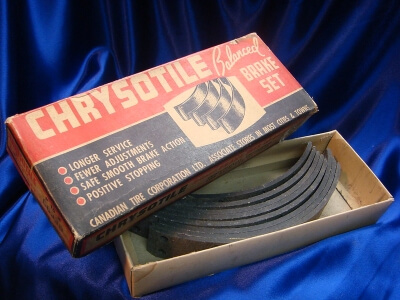Auto Mechanics and Asbestos
Asbestos in brake pads, clutches and other auto parts creates disease risk for thousands of professional and hobby mechanics each year. Auto mechanics can also expose their family to dust from damaged or degraded asbestos brakes and clutches.

Written by Michelle Whitmer • Edited By Walter Pacheco • Legally Reviewed By Yvonne Waterman
Asbestos.com is the nation’s most trusted mesothelioma resource
The Mesothelioma Center at Asbestos.com has provided patients and their loved ones the most updated and reliable information on mesothelioma and asbestos exposure since 2006.
Our team of Patient Advocates includes a medical doctor, a registered nurse, health services administrators, veterans, VA-accredited Claims Agents, an oncology patient navigator and hospice care expert. Their combined expertise means we help any mesothelioma patient or loved one through every step of their cancer journey.
More than 30 contributors, including mesothelioma doctors, survivors, health care professionals and other experts, have peer-reviewed our website and written unique research-driven articles to ensure you get the highest-quality medical and health information.
About The Mesothelioma Center at Asbestos.com
- Assisting mesothelioma patients and their loved ones since 2006.
- Helps more than 50% of mesothelioma patients diagnosed annually in the U.S.
- A+ rating from the Better Business Bureau.
- 5-star reviewed mesothelioma and support organization.
Testimonials
My family has only the highest compliment for the assistance and support that we received from The Mesothelioma Center. This is a staff of compassionate and knowledgeable individuals who respect what your family is experiencing and who go the extra mile to make an unfortunate diagnosis less stressful. Information and assistance were provided by The Mesothelioma Center at no cost to our family.LashawnMesothelioma patient’s daughter
How to Cite Asbestos.com’s Article
APA
Whitmer, M. (2023, December 6). Auto Mechanics and Asbestos. Asbestos.com. Retrieved April 16, 2024, from https://www.asbestos.com/occupations/auto-mechanics/
MLA
Whitmer, Michelle. "Auto Mechanics and Asbestos." Asbestos.com, 6 Dec 2023, https://www.asbestos.com/occupations/auto-mechanics/.
Chicago
Whitmer, Michelle. "Auto Mechanics and Asbestos." Asbestos.com. Last modified December 6, 2023. https://www.asbestos.com/occupations/auto-mechanics/.
How Auto Mechanics Are Exposed to Asbestos
Working with vehicle replacement parts that contain asbestos can pose a significant risk to auto mechanics, DIY home mechanics, hobbyists and others who work with cars. A single nanogram of brake dust can contain around 90,000 asbestos fibers — a significant hazard even where exposure is limited.
Many automotive manufacturers used asbestos for its affordability and heat-resistant properties. The material still exists in some asbestos auto body parts, such as aftermarket brake linings, clutches and heat seals, plus some high-end imports such as the Land Rover.
As these parts degrade and break apart over time, they release asbestos fibers into the air and onto the auto mechanic’s hair, clothes and skin. Airborne asbestos fibers can linger for days and are easily inhaled or ingested. Drum and disc brakes and asbestos clutch parts naturally degrade with regular use and may still contain up to 35% chrysotile asbestos.
There is evidence of auto worker asbestos exposure in repair shops, supply stores, manufacturing plants, truck stops and bus and train stations. Many of these facilities, along with home garages used by restoration enthusiasts, lack the proper air circulation or vacuum equipment for work on asbestos-containing materials.
Mechanics can’t identify asbestos-containing materials by sight alone, and many repair and cleaning techniques can severely worsen the risk of mesothelioma and asbestos-related disease. Knowing how to remove asbestos dust in the workplace safely can significantly reduce the chance of long-term illness.
Hazardous Cleaning Techniques
Since there is no safe way to identify asbestos-containing materials on sight, the Occupational Safety and Health Administration recommends that mechanics assume all brakes contain asbestos.
Studies show that improper auto shop cleaning methods lead to increased risks of mesothelioma and other asbestos-related diseases. The following brake cleaning techniques can release asbestos into the air and lead to dangerous exposure for auto workers:
- Vacuum Cleaning: Shop vacuums do not typically have the appropriate filters to catch and contain asbestos fibers.
- Compressed Air: Using a hose and compressed air to clean drum brakes can push asbestos fibers great distances through the air.
- Rags and Brushes: Wiping parts with a rag or using a brush on the assembly causes dormant asbestos to become airborne.
- Spray Bottles: Using spray bottles and solvents to clean parts don’t entirely remove asbestos fibers, which can still attach to skin and clothes once dry.
- Water Hose: Dampening asbestos dust prevents it from becoming airborne, but a water hose can spread asbestos further and create more risk once the area dries.
Auto Shop Safety Measures to Reduce Exposure
The Environmental Protection Agency provides information on OSHA’s asbestos regulations for automotive repair shop businesses. The EPA does not recommend brake or clutch repair for home or hobby mechanics.
OSHA separates its recommendations into those for businesses that perform five or more brake or clutch jobs a week and shops that complete less than five.
For repair shops that perform more than five jobs per week, OSHA recommends using one of the following preventative measures:
- Negative-Pressure Enclosure/HEPA Vacuum System Method: This vacuum system has a box with transparent plastic walls or windows. It fits securely around brake or clutch assemblies to prevent the escape of asbestos dust.
- Low Pressure/Wet Cleaning Method: Low-pressure spraying equipment wets the brake assembly and catches the asbestos-contaminated runoff in a basin, preventing brake dust from becoming airborne.
Shops that perform fewer than five brake or clutch jobs per week should use the following method:
- Wet Wipe Method: This procedure uses a spray bottle or other device to deliver a mist of water at low pressure. It wets all brake and clutch parts with amended water (water with a detergent). Workers then wipe these parts with a disposable cloth.

Asbestos Products Auto Mechanics Encounter in Cars

Asbestos became a common choice for brakes and clutches due to its heat resistance and strength. An estimated 900,000 automobile mechanics have experienced asbestos exposure from brake and clutch work, typically through “blowing out” brakes with an air hose during cleaning and beveling surfaces during a repair.
However, asbestos fibers are present in many other auto parts, and its popularity throughout the 20th century led to widespread exposure from asbestos in automobiles and transportation. Drum and disc brakes typically contained between 35% and 60% chrysotile asbestos.
As mechanics access areas for repair and expose brake housings and other compartments, the collected dust escapes into the lungs or stomach. Over time, inhaled and swallowed asbestos fibers can cause mesothelioma, an extremely deadly cancer.
The U.S. government did not regulate asbestos use in the automobile industry until the 1980s. Some vehicles, such as Ford’s Crown Victoria, continued to carry asbestos until 1993, and asbestos is still present in aftermarket parts, including:
- Brakes: During everyday automobile use, asbestos brake linings wear down through friction, releasing asbestos dust just as sanding wood creates sawdust. Brake housing and lining, collectively called brake shoes, can both contain asbestos.
- Clutches: Some clutch parts in use today, both in new and older car models, contain asbestos to control the heat produced by friction. During normal wear, the asbestos is ground down and may collect around the parts and clutch compartments.
- Hood Liners: Manufacturers have used asbestos fibers to produce millions of automotive hood liners due to their natural heat resistance.
- Gasket Material, Heat Seals, Valves and Packing: Before the 1970s, manufacturers used asbestos-containing parts throughout gas and fluid systems to regulate temperature.
Manufacturers That Produce Asbestos Automotive Parts
Several companies continue to manufacture and sell asbestos-contaminated auto parts. Many of the following companies closed down in the 1980s when the government started regulating asbestos parts. However, there is still no federal asbestos ban, and mechanics may continue to encounter old asbestos-containing products from the following companies:
- Raymark Industries
- Federal-Mogul
- LAS Replacement Parts Inc.
- Austin Auto Parts Inc.
- Canton Auto Parts Inc.
- Fisher Auto Parts Inc.
- Forest City Auto Parts Company Inc.
- G&T Auto Parts of Mid Orange Inc.
- Genuine Parts Company
- Globe Foreign Auto Parts Inc.
- LM Scanlon Inc.
- Potsdam Auto Parts Inc.
- Ren Auto Parts
- Scanlon’s Auto Parts Inc.
- Pep Boys
- Advance Auto Parts
- AutoZone
- O’Reilly Automotive Inc.
- Daimler Chrysler
- Ford Motor Company
- General Motors Inc.
Auto Mechanics and Asbestos-Related Diseases
Through many investigations, researchers concluded that asbestos contributed to higher rates of cancer among auto mechanics, especially when they work with brakes. Many scientific studies in recent decades have concluded that brake dust alone is not a cause of mesothelioma.
Through routine cleaning, workers who use shop vacuums can further spread asbestos fibers into the surrounding air. The fibers tend to linger in the air long after a job is done and can spread up to 75 feet from the work area, potentially exposing other mechanics and customers who enter the shop.
Airborne asbestos is easily inhaled and ingested if fibers get on hands and clothes. This problem is challenging for mechanics since they often get grease on their hands, and asbestos fibers can stick to the oil. Workers also inadvertently carry asbestos home on contaminated clothing, creating a source of secondary asbestos exposure for their families.
Asbestos-related diseases have a long latency period and can take several decades to develop. When symptoms appear, it is often too late for aggressive treatments such as surgery, leading to a poor mesothelioma prognosis. Finding a mesothelioma specialist allows affected mechanics to find treatment options earlier and potentially improve their prognosis.

Compensation for Auto Workers Exposed to Asbestos
For automobile mechanics, factory workers and DIY repair enthusiasts who have a history of asbestos exposure, finding a renowned mesothelioma lawyer is the best step toward asbestos compensation options.
Auto mechanics who develop an asbestos-related disease have options for receiving compensation. For example, the Motor Liquidation Company Asbestos Personal Injury Trust, created in 2012, has reserved over $625 million for injured workers and their families. Average settlements from this trust pay roughly $175,000.
George Chance, a former maintenance mechanic diagnosed with lung cancer, filed an asbestos claim in 2019 for exposure to asbestos products manufactured, sold, distributed or installed by several companies. The defendants included Advance Auto Parts, Goodyear Tire & Rubber Company, Ford Motor Company and General Electric Company.
In another claim filed in 2019, an Arkansas jury ruled against Honeywell and Pneumo Abex regarding a former brake-shoe worker. Ronald Burlie Thomas worked at Stuart’s Brake Shop in Little Rock from 1971 until 1983. He was diagnosed with mesothelioma in March 2017 and died later that year at age 72.
Chief U.S. District Judge Brian Miller awarded Thomas’ estate $18.5 million to cover Thomas’ pain and suffering, medical expenses, anguish to surviving family members and punitive damages.








